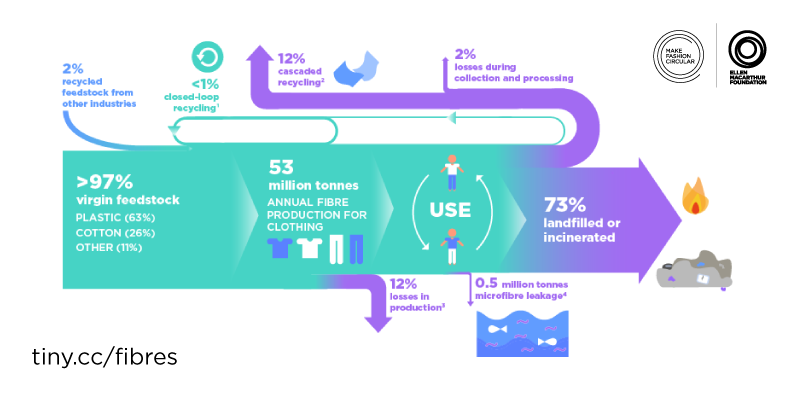
Existing trends in the linear and globally organized textile industry, have an enormous negative impact on the development of people, the planet and the economy. The sector is at the eve of an epic transition. Below this is illustrated by some striking data.
- In 2015, the global fashion industry generated revenues of 1.3 trillion dollar and the sector employed over 300 million people (EMF, 2017)
- Garments represent more than 60% of the total use of textiles worldwide (EMF, 2017).
- Fast fashion: between 2000 and 2015, the number of garments doubled from approximately 50 billion to over 100 billion garments. More than half ends up at dumpsites or in waste incinerator plants (EMF, 2017).
- In Europe and the United States, every year over 20 million tons of used and unused clothes end up at dumpsites or in waste incinerator plants (EMF, 2017).
- New garments are being thrown away very quickly. At average, a fast fashion garment is thrown away within one year after being purchased (EMF, 2017).
- Millions of employees in the textile industry are working under miserable and dangerous working conditions, due to unsafe production processes and the use of toxics. With its strong focus on low costs and short delivery times, the (fast fashion) industry exerts a lot of pressure on employees to make long days under harsh conditions and against very low wages. Whereas the textile industry contributes to employability, its activities also have a negative impact on local communities in developing countries or emerging economies, such as child labor or even slavery, the illegal discharge of polluted wastewater in local rivers that are also being used by local fishermen and for (drinking) water supplies.
- Fast fashion is an important factor in the huge waste of (raw materials for) garments. Less than 1% of the total amount of raw materials that have been used for the production of garments, is being re-used for the production of new garments. This implies a loss of 100 billion dollars every year. In the whole industry only about 13% of used raw materials is being re-used one way or the other. Mainly, this concerns the down-cycling of textile materials to less valuable products, such as insulation material and cleaning cloths, that are at the end of their lifecycle (EMF, 2017).
- In 2015, the global textile production contributed to emissions of 1.2 gigaton CO2-equivalents, which is more than the total emissions of the international aviation and shipping sector together.
- The textile industry has also a huge share in the global waste and the pollution of water:
- for the production of textiles (including the production of cotton), worldwide 93 trillion liters of water is being used, in other words: 93,000,000,000,000 liter water. The enormous water consumption contributes to the (deterioration of ) issues related to water supplies in many regions with a shortage of water.
- 20% of the global water pollution by the industry is caused by the coloring and processing of raw materials for textiles.
- raw materials used in textiles, such as polyester, nylon and acryl contribute to the plastic soup in our oceans; it is estimated that about 0.5 million tons of plastic microfibers are polluting the oceans due to rinsing while washing clothes.
- From the 28 pounds of textiles every Dutch citizen throws away annually, only 8 pounds (30%) is collected in separate fractions (Milieucentraal). In 2015, approximately 73,000 tons of discarded textiles have been collected separately in the Netherlands (CBS Statline, 2018). This means that in 2015 over 170,000 tons of textiles ended up as residual waste and, finally, in waste incinerator plants.
- If the exploding demand and supply of new garments continues, according to a ‘Business-As-Usual’ scenario (the so-called BAU scenario), in 2050 the total sales of garments would amount to approximately 160 million tons of garments: three times more than in 2015. Without a radical system change towards a circular textile economy, the negative impact on the environment will be catastrophic. In the BAU scenario, in 2050 the textile industry would:
- take up 26% of the total CO2-budget at a maximum rise in temperature of 2o Celsius
- use approximately 300 million tons of non-renewable raw materials (such as oil) annually
- be partly responsible for the accumulation of 22 million tons of plastic microfibers in the oceans.
Bronnen: Ellen MacArthur Foundation, Milieu Centraal, CBS Statline


